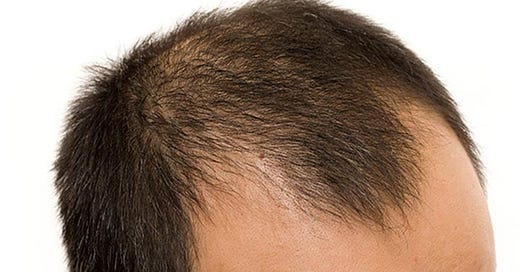I’m currently on a mixed dermatology and rheumatology post and have been attending lots of clinics.
Dermatology has been really intriguing as it really is a crossover between physical and mental health. I’ve seen severe acne, eczema and alopecia and when treatment works - it can completely transform the physical and psychological health of a patient. Things aren’t always straightforward though..
As a GP, I’m quite used to being asked about “side issues”. For example during a consultation with a patient for tonsillitis, a patient will typically ask “Doctor, what’s your view on this dry skin patch?”In dermatology - male or female pattern baldness seems to be quite a common “side issue".”
It’s not really a “side issue” especially as it can massively impact mental health. For instance, in a qualitative study interviewing 1536 men, the fear of men becoming bald was more important than factors such as ageing and becoming poor for self esteem. Patients can spend hundreds to thousands exploring treatment options including hair loss clinics as well as hair transplants. It’s a huge industry.
I thought I’d share some insight into how hair loss happens and how some of the consultants I have worked with advise their patients. So let’s go.
There are four stages of hair growth, as shown below:
Androgenetic alopecia is a fancy term for “hair loss with age”. It occurs due to increased activation of androgen receptors which shortens the anagen or growth phase in the normal hair growth cycle.
This is due to increased levels of testosterone, 5a-reductase (activates testosterone by converting it to dihydrotestosterone (DHT)) and an increased expression of androgen receptors.
Other conditions such as hypothyroidism, diabetes and lupus can also impact hair growth by shortening the anagen phase.
Currently there are two licensed treatments in the UK to help with hair growth. These are:
Minoxidil - This is applied topically to stimulate vasodilatation thereby increasing blood flow, induces of vascular endothelial growth factor (VEGF) expression increasing vascularization and prolonging the duration of the anagen phase via the activation of the beta-catenin pathway.
Finasteride - Inhibits the enzyme 5a-reductase which impairs the activation of circulating testosterone.
Current natural therapies can mimic the medication above with similar or greater effectiveness. These include:
Rosemary oil - This has been found to be as effective as minoxidil and works primary by inducing vasodilatation around hair follicles.
Caffeine - This has been found to inhibit the 5a-reductase enzyme hence reducing the conversion of testosterone to DHT.
Some less common natural remedies include ginger extract, coconut oil and argan oil.
So…. if a patient presents with a history suggestive of male or female pattern baldness, consider the following approach:
Rule out alopecia areata, an autoimmune condition which may require a short course of topical steroid treatment.
Does the patient have hypothyroidism, T2DM or lupus?
Advise patient regarding regarding over the counter remedies including rosemary oil or caffeinated shampoo.
Refer the patient for further treatment including minoxidil 2% or finasteride. \
Hope that was interesting!
Until next time :)
Check us out on our various pages
Website: www.paretoeducation.co.uk
Instagram: https://tdy.lol/lQSxv
TikTok: https://tdy.lol/AJdzQ
YouTube: https://tdy.lol/ZEoOt
Newsletter: https://tdy.lol/WnTBR
LinkedIn: https://tdy.lol/efLOB





